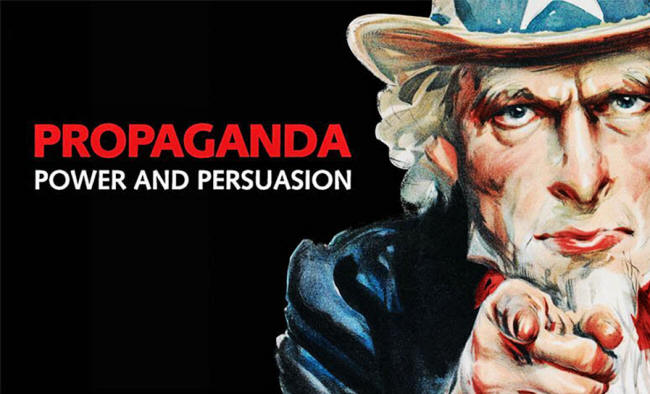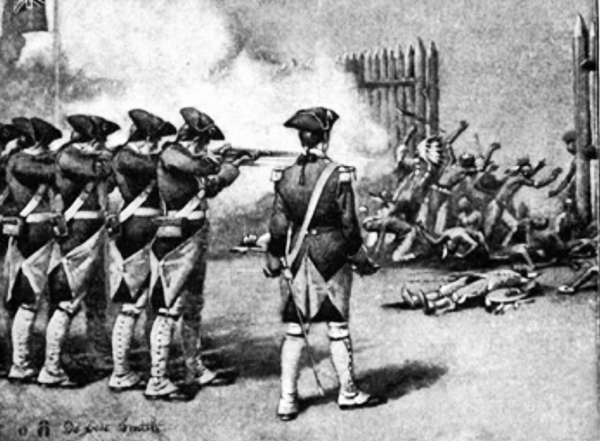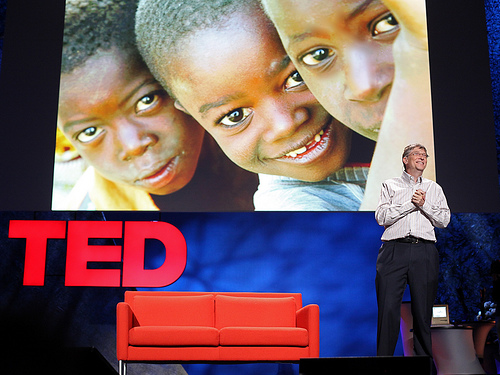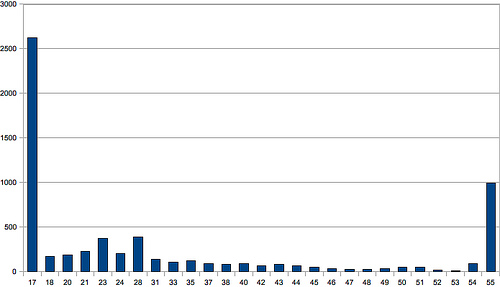from Medium Website
| Rod Driver is a part-time academic who is particularly interested in de-bunking modern-day US and British propaganda. This is the thirteenth in a series entitled Elephants In The Room, which attempts to provide a beginners guide to understanding what’s really going on in relation to war, terrorism, economics and poverty, without the nonsense in the mainstream media. |

“The conscious and intelligent manipulation
of the organized habits and opinions of the masses
is an important element in democratic society.
Those who manipulate this unseen mechanism of society
constitute an invisible government
which is the true ruling power of our country.
We are governed, our minds are molded,
our tastes formed, our ideas suggested,
largely by men we have never heard of.”1
Propaganda is the distortion of information to manipulate people’s thoughts and actions…
Many philosophers over the years have noted,
“The easiness with which the many are governed by the few.” 2
Chapter TWELVE – Force and Opinion –
The ancient Greek philosopher, Aristotle, realized that persuasive speakers can lead their audience into making unwise choices, and therefore believed that the ‘art of influencing opinion’ should be widely taught.
Unfortunately in Britain and the US, there is no formal teaching of how powerful people manipulate our opinions.
Propaganda-managed democracy
A democracy works best if decision-making is out in the open and policies can be thoroughly scrutinized, but present-day politicians and corporate leaders operate in secret, and spend a lot of money manipulating our opinions.
Most people associate propaganda with dictators, or with historical events such as World War 1 and World War 2.
However, propaganda is actually one of the most powerful forces within 21st Century Britain and the US, despite being rarely mentioned by the mainstream press.
The overall aim is to control people whilst they think they have freedom of action – this is sometimes called ‘engineering’ or ‘manufacturing’ consent. 3
The more specific goals are to limit the terms of any debate, and to direct our attention away from thinking critically about our military, corporate, economic and political systems.
Propaganda specialists now play an almost continuous behind-the-scenes role.
Much of the time, people are not even aware that their views are being manipulated. There is repeated, subliminal reinforcement. What we have ended up with has been labeled a propaganda-managed democracy. 4
People who do this work have stopped using the word propaganda, because of its negative association with war. It is now known as Public Relations (PR). When governments distort information this is colloquially known as spin.
The most powerful source of propaganda is mainstream media – newspapers and TV news and current affairs programs. This was discussed in detail in the two previous posts.
However, there are other sources of propaganda.
Some of these are discussed below.
Others, such as advertising, will be discussed in later posts.
Layer Upon Layer of Propaganda
Where discussions of propaganda do take place, commentators usually talk about individual pictures, newspaper articles, or political speeches, but propaganda is much broader and more complex than that. 5
Many parts of our society contain elements of propaganda, and they can influence our thoughts and our ideas for many years.
What starts out as a deliberate attempt to mislead people, gradually becomes the received wisdom if it remains unchallenged. It surrounds us and works in a subconscious way to influence our thoughts about almost every aspect of our societies – how they are structured, which aspects of society get talked about critically, and who benefits.
The framework for every important discussion contains unstated assumptions that go unquestioned. This sets the limits for which opinions are considered reasonable, and which are not.
When magazine editors decide who to interview, or a TV producer decides who to have as a guest, they are making decisions, sometimes subconsciously, about which opinions to take seriously, and whom they perceive as knowledgeable.
When editors decide whose obituaries will appear in their newspaper, they tend to celebrate establishment figures, reinforcing a message that we should treat them and their views as important.
When this happens repeatedly, day after day, year after year, readers and viewers will tend to be influenced by these ideas, and come to share similar views.
For example, if we talk about wealth, there is an unstated assumption that it is ok for some people or organizations to have unlimited wealth.
In fact we are bombarded with propaganda, in magazines like Forbes, which is intended to encourage us to celebrate extreme wealth, 6 and even to define success by how wealthy we are.
The evidence showing that concentrations of wealth, and extreme inequality, create huge problems for societies is mostly ignored. 7
We are indoctrinated to believe that the rich have ‘earned’ their wealth, or that success is based on merit.
Some people who have accumulated great wealth by committing serious crimes, such as
Bill Gates, set up foundations and give money to good causes as a way of whitewashing their reputations.
8
They make donations to universities or have buildings named after them.
As one commentator noted:
“Corporate fraudsters almost all use philanthropy as a cover. Because of all their goodness, people never look any further”. 9
This is all intended to make us less critical of those with great wealth, and therefore less critical of how our society works.
History, as taught in the US and Britain, is Propaganda
Censorship-by-omission, where important issues are not discussed (explained in the previous post) is important with historical propaganda.
Our history books have a western perspective, distorting events, exaggerating positives and minimizing or ignoring negatives. 10
A great deal of our history is propaganda to whitewash reputations and to celebrate the role of the wealthy and the powerful, and to erase their crimes and exploitation.

Genocide of Native Americans
Erased from History
People such as Winston Churchill are portrayed positively, with no discussion of his extreme, racist approach to killing people in Britain’s colonies.
Commentators talk unquestioningly about British and US ‘values’, like ‘freedom’ or ‘democracy’, without mentioning that the values that influence policymaking the most include,
power, money, war and exploitation…
I cannot stress this point enough.
The positive portrayal of rich and powerful people, both historical and in the present day, and the censorship-by-omission of all their crimes and unethical activities, and the huge amount of damage that their actions have caused to people at home and abroad, is incredibly powerful propaganda.
During recent protests about racism, statues were pulled down in Britain and the US. 11
These statues have played a propaganda role.
They are intended to show how important the individuals were, and make us less questioning of our history and of earlier decision-makers.
Similarly, many British country houses were built with money that came either directly from the slave trade, or from industries that used slaves, or from compensation given to slave owners when slavery was abolished. 12
The houses were status symbols when they were built, and they now stand as historical monuments to the people who built them.
Some churches contain monuments to wealthy donors who helped to pay for the building of the church, with no indication that their wealth came from slavery, or the drug trade, or colonial exploitation.
Streets are named after famous people, some of whom committed serious crimes, but their true history is rarely mentioned. This propaganda is remarkably effective and creates what is known as ‘collective amnesia‘.
Whole societies deny their history, and British and American citizens have become remarkably uncritical of their military, corporate, economic and political systems.
Museums do Propaganda
Museums and other exhibitions are an important part of this historical propaganda.
The displays at the Imperial War Museum are notoriously distorted, celebrating Britain’s history of violence, and misrepresenting what actually happened and why. 13
Medals are celebrated, even if they were awarded for participation in colonial plunder and associated massacres, and the soldiers are presented as heroes. Powerful people involved in aggression and violence clean up their stories.
There is an unstated assumption that US and British politicians had good intentions in their foreign policies.
But this needs to be stated clearly, questioned and challenged, because the evidence shows that US and British leaders have not had good intentions in their foreign policies.
Even a display about propaganda by the British Library in 2013 did not have any discussion about censorship-by-omission. 14
Think Tanks and Universities do Propaganda
Think tanks claim to be independent research establishments, but they are usually funded by wealthy donors such as billionaires or big corporations, so their output reflects the interests of those donors. 15
Mainstream publishers rarely publish genuinely critical books. Before the financial crisis in 2008, they declined many books that explained the problems with the financial system. 16
Most critical writing is in books published by small publishers, and those books are rarely reviewed in the mainstream press.
Universities teach Economics, Finance, Politics, International Relations and War Studies in heavily distorted ways. The majority of academics in these subjects present only a narrow range of mainstream opinions and ignore the most critical views.
Critical academics have complained that most academic journals reinforce mainstream thinking by not accepting work that is too critical.
This has been particularly notable in economics, where students at many universities have been protesting, since the 2008 financial crisis, that what they are taught is irrelevant to the real world. 17
People are rewarded for not challenging the system
The honours system in Britain, where awards such as peerages and knighthoods are given out, is notorious for rewarding party fundraisers and political allies, 18 and more generally for rewarding people who have been successful within the establishment system.
The Nobel Peace Prize is given to sociopathic war criminals such as Henry Kissinger and Barack Obama.
The prize for economics is awarded to people who have promoted some of the most extreme economic ideas such as Milton Friedman. The economics prize was set up by the Swedish central bank to promote neoliberal (an extreme form of capitalism) ideas, 19 and to make economics seem more scientific than it really is.
These awards are mostly given to people who are not strongly critical of how our societies work.
Not everyone is conscious that they spread propaganda
The successful spread of propaganda involves people repeating and passing on distorted information that they were exposed to in the past.
Most people are unaware they are doing it. When economics lecturers teach economic theories that end up benefitting the rich, some of them are unaware they are doing so.
Some journalists believe the propaganda that they have been exposed to by governments and corporations, so they repeat it.
Any time someone repeats something that they have read in a mainstream newspaper, or seen on television news or current affairs programs, there is a high probability that they are repeating propaganda.
The Overton Window – Alternative Views Are Not Discussed
The repetition of some points-of-view is so widespread that these perspectives become the accepted norm, so individuals engage in self-censorship, where they become reluctant to express dissenting views, afraid that they will be considered ridiculous by their friends and colleagues.
This becomes reinforcing, so that the acceptable range of views becomes very narrow.
This is known as the ‘Overton window’. 20
Alternative views are essentially shut down.
This desire to conform with others around us is a very powerful psychological trait that will be discussed in a later post.
Resisting propaganda is possible – Seek out alternative views
People with strongly critical opinions rarely appear on discussion programs or in magazines.
In 2014, the singer P.J. Harvey was a guest editor on BBC Radio 4’s Today program. All of her guests were critical thinkers. This was unique in 21st century BBC broadcasting.
Voices and opinions that are rarely heard finally had an opportunity to explain what is really going on. 21
Most people do not like to admit that they are susceptible to propaganda, therefore they claim it is not there.
We are all regularly manipulated.
There is no shame in admitting it.
We can never change things if we do not admit that people are trying to manipulate us.
Understanding the extent of propaganda in Britain and the US is the key to understanding how political and corporate criminals have been able to get away with their activities for so long.
Notes
- Edward Bernays, Propaganda, 1928
- David Hume, 1711-1776, cited in Noam Chomsky – Deterring Democracy – 2006
- A similar expression, ‘Manufacturing Consent‘, is the title of a book by Edward Herman and Noam Chomsky about the media. This book is discussed more in the posts about the failings of the media.
- Alex Carey, Taking The Risk Out Of Democracy, 1996, p.19
- Robert Jackall (ed.) Propaganda (Main trends of the Modern World), 1994
- Forbes, ‘World’s Billionaires List – The Richest in 2020‘
- Karen Rowlingson, ‘Does income inequality cause health and social problems‘, Joseph Rowntree Foundation, Sep 2011
- Michelle Celarier, ‘The 10 most toxic Philanthropists‘, 24 Sep 2019
- Marianne Jennings, The seven signs of ethical collapse: How to spot moral meltdowns in companies…before it’s too late, 2006
- – James W. Loewen, Lies My Teacher Told Me: Everything Your American History Textbook Got Wrong, 1996
– Howard Zinn, A People’s History of the United States, 2015
– The Crimes of Winston Churchill
- BBC, ‘George Floyd protests – The statues being defaced‘, 10 June 2020
- Sanchez Manning, ‘The stately homes built on the back of slaves‘, Independent, 3 March 2013
- Louis Allday, ‘The Imperial War Museum in London – A Lesson in State Propaganda?’, Monthly Review online, 7 Sep 2016
- Personal Observation by the author on visiting the British Library exhibition entitled ‘Propaganda, Power and Persuasion’, 2013
- Tamasin Cave and Andy Rowelll, A Quiet Word: Lobbying, Crony Capitalism and Broken Politics in Britain, 2014
- Michael Hudson, J is for Junk Economics, 2017
- Joe Earle, Cahal Moran and Zach Ward-Perkins, The Econocracy: The perils of leaving economics to the experts, 2016
- Andrew Grice, ‘David Cameron Honours list would embarrass a medieval court‘, Independent, 4 Aug 2016
Also see: https://en.wikipedia.org/wiki/Cash-for-Honours_scandal
- Avner Offer and Gabriel Soderberg, The Nobel Factor: The prize in economics, social democracy and the market turn, 2016
- https://en.wikipedia.org/wiki/Overton_window
- ‘Joyce Macmillan – Why politics deserves a new voice‘, The Scotsman, 3 Jan 2014
by Clay Burell
February 20, 2009
from EducationChange Website
Once more into the breach re: the Gates TED Talk (video at end of page), and my post contesting its framing of teachers. Reader Jean suggested I reflect on the decision to create and post the video in that post, and I’m happy to oblige.
I find the whole thing fascinating.

First, the background.
Here below is the transcript of the video I made. All text is written, not spoken. The only audio is an electric current sound effect during my text, and the audio of the historical documentary I edited into it:
In his 2009 TED Talk, Bill Gates discussed his “two top problems.” The first? Malaria. He showed Powerpoint slides of huge mosquitos, then released a swarm onstage. The audience gasped.
By the end of the talk, this history teacher was reminded of a film he’d shown his students: [Cut to the “plague of rats” footage in the 1940 German propaganda film, The Eternal Jew.]
Cut to: Gates’ second “top problem” was: Teachers. That film about rats? Uncut, it continued: [Cut to: The film’s comparison of the problem of rats to the problem of Jews. Lots of statistics in it justifying the anti-semitic message.]
Cut to: Gates concludes his TED Talk,
“I only had time to discuss two problems. There are others: AIDS, pneumonia…”
Let’s review Gates’ top problems:
- Malaria
- AIDS
- Pnuemonia
- Teachers
Mr. Gates, One of these things is NOT like the others. Before you “change the world,” please change your rhetoric. It has disturbing precedents.
Signed,
An Offended Teacher
In the text above the video, I wrote (with emphasis added):
It was no fun making this imperfect little video response to Gates’ talk. But it was no fun watching his characterization of the problem of “teachers.”
I’ll get into the substance later, but symbolism, rhetoric, and organization – as any good propagandist knows – communicate on dangerously unconscious levels. While I’m not accusing Gates of consciously framing teachers the way he does, I am suggesting he should be more conscious of such things.
They have effects, intended or not.
I concluded by asking readers to tell me if I was off-base.
- one said no, he was angry too
- one offered no opinion
- three others, two emphatically, said yes
Debate went back and forth at great length. I was making unjustified assertions, I was told. I disagreed.
Finally, I asked what unjustified assertions I had made that I was being asked to back up, and this is the reply:
The claims I want you to back with evidence:
- that Gates wants to get rid of all teachers (like the Nazis wanted to get rid of all Jews)
- that Gates thinks teachers are “pestilent” and “plague-like” (I’m using these terms because they are used to describe rats)
- that Gates thinks all teachers, in general, are a problem
I replied that I had made none of those assertions – and reviewing every comment in that long thread, I still maintain that. More on that below.
Then Jean commented that, to paraphrase, my request that readers “tell me if I’m off-base” turned into intransigence when challenged, true to a psychology study she cited from the ’70s. She added that she didn’t disagree with my point so much as my “tactic” in making it, by which I assume she means the observed similarities to the German propaganda film, or the video itself. Then she asked me to reflect.
I’ve been reflecting all along, because it’s the first time I’ve ever watched a presentation that made me think – and say,
“That reminds me of Hippler’s film. It’s disturbing.”
But Jean’s nudge pushed me to question that possible intransigence as well. I doubt my response will satisfy everybody, but here goes.
On the use of that film
So my first reflection is this:
- If the film were a product of, say, Stalinist anti-bourgeois propaganda, placing “capitalist-roaders” within an epidemiological frame
- if it were a McCarthy-era “Red Scare” piece doing the same with the communist threat within our borders
- if a Jim Crow era film like The Birth of a Nation,
…would the comparison have been less objectionable to some?
More to the point:
- Is any attempt to take examples from 1930s and ’40s Germany doomed to resistance and cries of foul play?
- Would a comparison to, say, Leni Reifenstahl fare any better?
- Or is it just taboo to connect to specific instances from this period because they will be confused with broad-brushed, full-on identifications that, because A does what B did, A is a B?
What I should have said more clearly
…and what I still say: Gates’ Talk works like propaganda for today, not for yesteryear
The unfortunate truth is, the Hippler film is the one that came to mind as I watched Gates walk us through the problems of disease #1, then of “the problem of making great teachers” – if it’s a problem, that means today’s teachers aren’t great, and thus “bad teachers are the problem,” Gates’ positive delivery aside – then disease #2 and #3.
The film is a staple of classroom propaganda lessons precisely for its epidemiological framing of a group of humans.
I would have given anything to have another example at the ready instead, but I didn’t. (And honestly, the origins of that film make the point, more forcefully than any other example, that such rhetoric – or more accurately, semiotics – does indeed have “disturbing precedents.”)
Much more below the fold….
I will, though, try to make more clear what my original statement – that I wasn’t accusing Gates of consciously using this tactic – apparently didn’t, and point to a difference that would have been helpful to point out originally: the German film makes an explicit comparison between the disease trope and the human one. It makes the explicit simile, A is like B.
Of course Gates never makes that claim concerning his diseases and our teachers, and I never said, or meant to imply, that he did.
This does not, however, change the semiotic fact: the Talk lays down a unifying concept, “biggest problems,” then presents two dominant signifiers: malaria and teachers. After teachers, two more signifiers are laid down in quick succession, AIDS and pneumonia, to close the frame. Three diseases now surround one class of human professionals.
I argue this is dangerous because psychologically, audiences don’t need a comparative operator – “like” or “as” – to associate the four examples in his talk with the idea of “disease.”
The preponderance of epidemiological imagery on both sides of the teacher imagery encourages precisely that association. (And as I said in the comment thread, Gates’ dropping of “diarrhea” into the beginning of the speech adds yet another touch of the same.)
Am I saying this second association is conscious on Gates’ part, or that the audience will walk away with it consciously either? I’ve already said “no.”
But we do, as a species, make unconscious associations, and those can be perhaps more dangerous than conscious ones. For a different example of this, here’s psychologist Phillip A. Goff discussing his research about the effects of unconscious associations on our conscious behavior and volition.
Interestingly, he wrote the following after noting the indifference many people expressed about the recent New York Post editorial comic many claim links the ideas of “Obama,” “ape,” and “murder.”
Dr. Goff begs to differ that people should “just relax” about such associative performances:
[..]Though much of the reaction to the cartoon has been outrage at the implication that our 44th president is remotely simian, there have been other messages in the blogosphere as well.
A few pleaded with us to see reason in this post-Obama era. They begged us to understand that the cartoonist clearly meant to impugn congress, Wall Street executives and academic economists and that there was no racial subtext to the piece.
Others saw the cartoon as racist but declined to become outraged. Saw the injustice in the image, but saw it as a minor injustice, not one worth worrying too much about. After all, having a black president means that America is post-racial and does not need to worry about petty things like harmless pictures in a paper.
The messages in my inbox mirrored the commentaries I saw online. A few (though not many) defending the cartoon. Many more exasperated with indifference. All of them insisted this was a little thing.
The best science available suggests otherwise.
For the better part of the past seven years, my colleagues and I have conducted research on the psychological phenomenon of dehumanization. Specifically, we have examined
cognitive associationsbetween African Americans and non-human apes.
And the association leads to bad things. When we began the research, we were skeptical of whether or not participants even knew that people of African descent were caricatured as ape-like – as less than human – throughout the better part of the past 400 years. And, in fact, many were not.
However, even those who were unaware of this historical association demonstrated a cognitive association between blacks and apes. That is, when they thought of apes, they thought of blacks and vice versa – when they thought of blacks, they thought of apes.
But the fact of this cognitive association was not the most disturbing part of the research. Rather, it was the fact that the association between blacks and apes could lead to violence.
In one study, participants who were made to think about apes were more likely to support police violence against black (but not white) criminal suspects. The association actually caused them to endorse anti-black violence. Most disturbing of all, however, was a study of media coverage and the death penalty.
Looking at a sample of death-eligible cases in Philadelphia from 1979 to 1999, the more that media coverage used ape-like metaphors to describe a murder trial (i.e. “urban jungle,” “aping the suspects behavior,” etc.) the more likely black suspects, but not white suspects were to be put to death.
(Full post
here.)
Not “de-humanization,” but de-professionalization – and privatization
Now I am not saying anything silly like Gates is trying to either de-humanize teachers, or to cause violence toward them.
What I am saying is that I see evidence of an agenda to de-professionalize teachers in his push for standardized testing, and the data-tracking of that testing to be used to retain or fire teachers.
Rather than address the valid concerns that may have led Congress to strip funds for these data-systems from the recent Recovery Bill, Gates dismissed it with a hint of derision by saying the funds were removed “because some people are threatened by this stuff.” (I copied and pasted some of those valid reasons in the bottom of the comment thread to the last post on Gates, if you want to read them.)
I also point to Gates’ championing of KIPP charter schools as evidence that he also aims to weaken or destroy – do political violence to – teachers’ unions and non-privatized, traditional public schools.
(For the best summary I’ve read of the damning consequences of charter schools for universal and equitable public education, read a recent post by our newest guest-blogger, Sharon Higgins, on Perimeter Primate.)
Gates points to KIPP twice as his example of “where great teachers are being made,” and KIPP itself admits in word and deed that it is anti-union.
- First, Gates gives his gushing anecdote about the “sports rally” energy he witnessed among teachers during his visit to a KIPP school – and gee, is it just me, or wouldn’t any school show some noticeable energy on the day the richest billionaire in America comes to walk its hallways and sit in on its classes? If ever there was a case of the experimenter influencing the experiment, it was this one.
- Second, Gates gives that free copy of Jay Matthews‘ KIPP-boosting Work Hard Be Nice to each member in his audience. Think about that: the TED audience comprises some of the wealthiest and most influential people in America. They paid around $6,000 per ticket to this event, and surely could afford to buy the book themselves.
By giving a copy to each member of his audience (to which they bizarrely applaud as if they were peasants receiving cake from Marie Antoinette), Gates is instead forcing into their lives the KIPP answer to education reform, rather than any number of less radical, less anti-union, and better-researched reform solutions by the likes of Linda Darling-Hammond or the leaders of the Broader, Bolder Initiative.
Worse still, since Gates’ mosquito-unleashing stunt gave his TED Talk video even more publicity than its already-high profile as this year’s keynote, Gates in effect hawks the Matthews/KIPP solution to the thousands of people who watch the Talk online.
Now consider that Arne Duncan is making the same talking-points – KIPP and data-tracking systems, which means privatized, test-driven, anti-union public schools – when discussing his plans, as the new Secretary of Education empowered to direct over $50 billion of federal funds to reform efforts in the 50 states.
And consider that he’s making the points in the same simplistic, “these are the answers” language Gates is, and at least entertain my argument that this spells trouble for public education and the teaching profession.
From [anti-union, by no means “proven,” as even Gates’ chart suggested] Teach for America to the [byno means “proven“] KIPP charter schools to instructional innovations at colleges and universities, we have proven strategies ready to go to scale.
(
Duncan speech on ed.gov)
Mr. Duncan said he intended to reward school districts, charter schools and nonprofit organizations that had demonstrated success at raising student achievement… Programs that tie teacher pay to classroom performance will most likely receive money….
(
source)
Duncan said he wants states to use other funds allocated in the stimulus package to adopt accountability-oriented reforms…such as the creation [in NYC] of a comprehensive data system, called ARIS, and the introduction of a program that gives some teachers bonuses based on their students’ test scores.
(
While I’m on Duncan – and Gates, for that matter – I’ll go ahead and state that they both address other forms of professional development for teachers, such as mentorships for new teachers, that can obviously help.
But what both of them do by shining the spotlight on KIPP and value-added (test results-based) teacher pay and retention is distract from much larger issues that cry for attention: under-funded schools in poor districts, increasing racial segregation resulting from charters, and the relegation of non-charter public schools to only the worst-performing students from the least-privileged households. (Again, see Sharon Higgins’ post for this bigger picture.)
We’re all watching the magician’s right hand, when we should be watching the left.
Further, I didn’t note another similarity between Gates’ talk and Hippler’s film in the original post, but I will, in addition to much more below.
The “Top Quartile Teachers” Myth
About those charts and statistics
Just as that unfortunate propaganda film uses all sorts of statistics, maps, and other technocrat flummery to give it the veneer of authority, so does Gates’ TED Talk (see far below video.)
A quick example is Gates’ unambiguous assertion that “research has shown” that, if only all students had the “top quartile” of teachers for four years straight, America would bypass Asia and top the world in student performance.

The NYTimes Nicholas Kristof picked up on the same meme, so off the nation goes swallowing Gates’ framing of this “research” when in fact, what Gates reports as “fact” was only speculation in the original research – and disproven speculation at that.
Gotham Schools gives us what Gates (and Kristof) don’t:
Wow, erasing the black-white testing gap in four years sounds like a pretty good deal. And just from being taught by some really great teachers! There must be some evidence of this for it to show up in the New York Times, wouldn’t you think?
Some study somewhere that actually showed that black students exposed to teachers in the top quarter of the teacher effectiveness distribution for four years in a row can routinely move from the 16th percentile in the test score distribution (roughly the black average) to the 50th percentile (roughly the white average)?
Maybe that
Los Angeles studywill show the way. Nah, that’s just a “suggestion” by Robert Gordon, Tom Kane, and Doug Staiger that the five percentage point increment in performance from having a teacher in the top quartile, and the five percentage point decrement from having a teacher in the bottom quartile, could cumulate over time – a 10 percentage point swing for four years in a row would more than close the 34 percentage point gap between the average black student and the average white student.
The problem is, as
eduwonkettepointed outlast summer, Brian Jacob and his colleagues have shown that these effects do not cumulate. Only about 20% of the effect remains after a single year, and only about 12% after two years. After two years, then, the 10 percentage point swing is down to about 1 percentage point.
It gets worse.
The notion of a “great teacher” identified via value-added effectiveness implies that we can identify who these teachers are, and they’ll always be great. The reality is, however, that the vaunted value-added methods show that a teacher who is “great” one year may not be so hot the following year.
In a recent National Center on Performance Incentives
report,Dan McCaffrey,Tim SassandJ.R. Lockwoodfind that the year-to-year correlation in teachers’ value-added scores are in the range of .20 to .30. This also implies that a teacher whose students gained five percentage points in one year might have students only gain one or two percentage points the following year.
Better than chance, to be sure, but what is a matter of chance is whether you get a teacher when she or he is having a good year or a bad year.
And the likelihood of big cumulative effects from exposure to “great teachers” just isn’t there.
Sorry, Mr. Kristof, no magic bullets in identifying and rewarding “great teachers” who can effortlessly close the achievement gap.
Now, can we get back to talking about teaching instead of teachers?
(Full post
here.)
We do well to include Mr. Gates in that final question.
Oh but wait, his TED Talk is viral, and Kristof at the NYTimes has given it a tailwind. The truth will never catch up.
Even if this were true, and we could use Gates’ magic test-data tracking system to identify “great teachers,” Diane Ravitch reduces the whole idea to absurdity anyway with this thought-experiment about how, exactly, the data would lead to any meaningful implementation.
She’s talking about Kristof, but Kristof is touting the same “top quartile/data tracking” meme Gates does:
So, let’s deconstruct a bit.
Kristof approvingly cites the economists who say that four consecutive years of a great teacher would close the achievement gap. Unfortunately he does not seem to realize that the economists were writing theoretically (and the relevant studies actually say that five consecutive years of a great teacher would have this result).
This happy outcome has NEVER been demonstrated in any school or school district. It is a projection of an econometric speculation.
If I read Kristof correctly, a “great” teacher is one who can produce higher test scores. We know that this can happen through relentless test-prepping. Is that what a great teacher does?
But if that is the definition of a great teacher, then we can’t possibly identify them until they have had at least three, or better yet, five years in the classroom, so there is sufficient data showing that they produced dramatic gains in their classroom.
So, that means that no new teacher – certainly no Teach for America teacher – could possibly be a great teacher, because we don’t know whether they are great teachers until they have created a consistent record of big test score gains over three-five years.
Let’s suppose that a district uses its data to identify the teachers who consistently produce big gains.
What happens next?
Do these teachers get assigned to the lowest-performing schools?
Which children in those schools are assigned to these teachers?
What happens to these teachers if they don’t get the big gains in the next years?
No one has tried to explain how this would be implemented, whether successful teachers would be willing to go wherever they are assigned, and how their services would be parceled out among many needy students.
As for entry into teaching, it sounds as though Kristof is saying that anyone should be accepted as a teacher. He is ready to scrap certification, graduate degrees, SAT scores.
Maybe you don’t need to be a college graduate to be a great teacher. Why not hire college freshmen as teachers? or high school seniors?
Isn’t it wonderful that we have economists with tons of data (but no practical experience) to tell us how to find and reward great teachers?
Again, a great question for Gates as well.
To all of which I say, again: Gates’ talk has more than a few classic characteristics of propaganda. Intent or no intent is beside the point.
Bill Gates Spills the Beans!
by C. Linderman Sr.
ATO Press
26 February 2010
from AutismtodayOnline Website
See below video and pay attention to the 4 minute 40 second about mark in this film.
In this film, Bill Gates states what I have been trying to tell my Linderman Live Radio show listening audience and my readership here on this site for some time now: there are elitist scum bags on this planet that want to cull the population.
Mr. Gates outlines the use of health care reform, reproductive health care initiatives and VACCINES to… facilitate the DEPOPULATION of the planet!
If vaccines and access to health care are designed to make us healthier and in the process (by default) live longer:
- How in the hell does this equate to DEPOPULATION?
- Wouldn’t this actually raise the population of the planet if these “lifesaving” vaccines actually did what our medical and public health officials claim?
So the only obvious conclusion to be made from Bill Gates and others of his ilk, is that they are lying to us about the vaccines and their true intentions.
Just have a listen for yourselves…
Bill Gates on Energy – Innovating to Zero!
from YouTube Website












